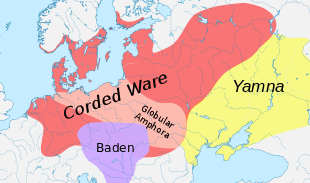Globular Amphora culture

The Globular Amphora Culture (GAC), German Kugelamphoren-Kultur (KAK), ca. 3400–2800 BC, is an archaeological culture, thought to be of Indo-European origin,[1] preceding the Corded Ware culture in its central area. Somewhat to the south and west, it was bordered by the Baden culture. To the northeast was the Narva culture. It occupied much of the same area as the earlier Funnelbeaker culture. The name was coined by Gustaf Kossinna because of the characteristic pottery, globular-shaped pots with two to four handles.
| Part of a series on |
| Indo-European topics |
|---|
 |
|
|
Origins |
|
Archaeology Pontic Steppe Caucasus East-Asia Eastern Europe Northern Europe Pontic Steppe Northern/Eastern Steppe Europe
South-Asia Steppe Europe Caucasus India |
|
Peoples and societies Indo-Aryans Iranians Europe East-Asia Europe Indo-Aryan Iranian |
|
|
Globular Amphora |
Extent
It was located in the area defined by the Elbe catchment on the west and that of the Vistula on the east, extending southwards to the middle Dniester and eastwards to reach the Dnieper. West of the Elbe, some globular amphorae are found in megalithic graves. The GAC finds in the Steppe area are normally attributed to a rather late expansion between 2950-2350 cal. BC from a centre in Wolhynia and Podolia.
Economy
The economy was based on raising a variety of livestock, pigs particularly in its earlier phase, in distinction to the Funnelbeaker culture's preference for cattle. Settlements are sparse, and these normally just contain small clusters pits. No convincing house-plans have yet been excavated. It is suggested that some of these settlements were not year-round, or may have been temporary.
Burials
The GAC is primarily known from its burials. Inhumation was in a pit or cist. A variety of grave offerings were left, including animal parts (such as a pig's jaw) or even whole animals, e.g., oxen. Grave gifts include the typical globular amphorae and stone axes. There are also cattle-burials, often in pairs, accompanied by grave gifts. There are also secondary burials in Megalithic graves.
Interpretation
The inclusion of animals in the grave is seen as an intrusive cultural element by Marija Gimbutas. The practice of suttee, hypothesized by Gimbutas is also seen as a highly intrusive cultural element. The supporters of the Kurgan hypothesis point to these distinctive burial practices and state this may represent one of the earliest migrations of Indo-Europeans into Central Europe. In this context and given its area of occupation, this culture has been claimed as the underlying culture of a Germanic-Baltic-Slavic continuum.[2]
Notes
- ↑ Marija Gimbutas (2001). The Living Goddesses. University of California Press. p. 188. ISBN 978-0520229150.
- ↑ J. P. Mallory and D. Q. Adams, Encyclopedia of Indo-European Culture, Fitzroy Dearborn Publishers, London and Chicago, 1997., "Globular Amphora culture"
Sources
- J. P. Mallory, "Globular Amphora Culture", Encyclopedia of Indo-European Culture, Fitzroy Dearborn, 1997.
- Mikhail M. Charniauski et al. (eds.), Eastern exodus of the globular amphora people: 2950-2350 BC. Poznań, Adam Mickiewicz University, Institute of Prehistory 1996, Baltic-Pontic studies 4.